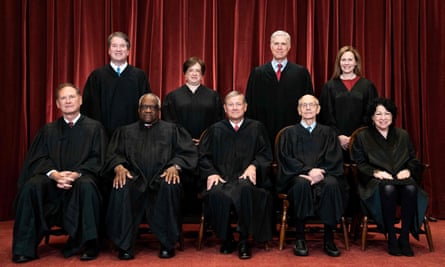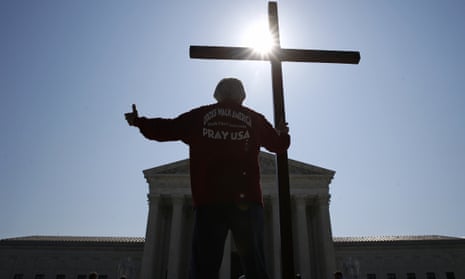Linda Greenhouse’s byline became synonymous with the supreme court during the 30 years she covered it for the New York Times. She excelled at unraveling complex legal riddles for the average reader. She also had tremendous common sense – an essential and depressingly rare quality among journalists.
Both of these virtues are on display in her new book, which chronicles “12 months that transformed the supreme court” after the death of the liberal lion Ruth Bader Ginsburg and the obscenely rapid confirmation of her conservative successor, Amy Coney Barrett.
As others have pointed out, Barrett’s ascension was the crowning achievement of a decades-long project of the American right, to pack the highest court with the kind of people who delight in telling graduating students things like the proper purpose of a legal career “is building the kingdom of God”.
Barrett is also the sixth Catholic appointed to the court. Another, Neil Gorsuch, was raised Catholic but now attends the church of his wife, who was raised in the Church of England.
Greenhouse describes the Federalist Society as the principal engine of this foul project. Founded in the second year of the Reagan administration to change the prevailing ideology of the leading law schools, its 70,000 members have become the de facto gatekeepers for every conservative lawyer hoping to serve in the executive branch or the judiciary.
Most students of the judiciary know that all 226 judges appointed by Donald Trump were approved by the Federalists. But until I read Greenhouse’s book I never knew that every one of the 500-plus judges appointed by the two Bushes also earned the Federalist imprimatur.
“Its plan from the beginning was to … nurture future generations of conservative law students” who years later would form the pool from which “conservative judges would be chosen”, Greenhouse writes.
She also adds the telling detail that makes it clear that this situation is even worse than it appears. After Gorsuch thanked a Federalist banquet “from the bottom” of his heart, after his confirmation to the supreme court, the then White House counsel, Don McGahn, told the same gathering it was “completely false” that the Trump administration had “outsourced” judicial selection to the Federalists.
“I’ve been a member of the Federalists since law school,” said McGahn. “So frankly, it seems like it’s been in-sourced.”
Greenhouse’s main subject is the impact on the law of the replacement of a celebrated progressive, Ginsburg, with the anti-abortion and anti-contraception Barrett. A meticulous examination of the most important cases decided during Barrett’s first term demonstrates how the new justice contributed to Chief Justice John Roberts’ determination to “change how the constitution” understands race and religion.
The centuries-old wall between church and state is being eroded and government efforts to promote integration – or prevent resegregation – are under steady attack.
Roberts’s opposition to important sections of the 1965 Voting Rights Act goes all the way back to his service in Ronald Reagan’s justice department in the early 1980s. As chief justice he made his youthful scorn for the virtues of integration into the law of the land, writing a majority decision invalidating the plans of Seattle and Louisville to consider race to prevent resegregation of public schools. By a vote of 5-4 the court ruled the consideration of race violated the constitution’s guarantee of equal protection.
Roberts’s opinion declared that the school systems’ “interest in avoiding resegregation was not sufficiently ‘compelling’ to justify a racially conscious remedy”.

For most of the country’s history, the establishment clause of the constitution has prevented the government from “endorsing or coercing a religious practice or viewpoint”, Greenhouse writes, while “the free exercise clause requires the government to leave believers free to practice their faith”.
But Roberts and his allies have thrown things upside down, turning the free exercise clause “from its historic role as a shield that protected believers from government interference into a sword that vaulted believers into a position of privilege”.
Greenhouse is a woman of convictions. Even as a reporter, she was famous for taking part in a march supporting abortion rights. In a previous book she bragged of contributions to Planned Parenthood. But none of her critics could ever find any evidence that her stories in the Times were slanted by her personal beliefs.
That objective stance was entirely appropriate when she was a daily reporter. But book writing is different. After doing such a good job of describing the decades-long rightwing campaign to produce a court whose views are increasingly at odds with the majority of voters, Greenhouse doesn’t endorse any ideas about how to remedy the situation.
She shows no enthusiasm for the idea of expanding the number of seats on the court, which was championed by Pete Buttigieg and others during the 2020 election, and she doesn’t even support the idea that 83-year-old Stephen Breyer should feel any pressure to retire during the current Congress, to make sure Joe Biden can appoint, and a Democratic Senate confirm, a liberal successor.
Similarly, Greenhouse never suggests Ginsburg was wrong to stay in office until her death, rather than retire during Barack Obama’s time in office so that she wouldn’t be replaced by someone like Barrett.
Unwilling to regulate dark money’s vicious role in our politics, and happy to eviscerate the most basic protections of the Voting Rights Act, the court is increasingly tethered to religious rightwing orthodoxy.
Greenhouse does a superb job of describing how we got here. What she lacks is the passionate imagination we need to re-balance an institution which poses an urgent threat to American democracy.
Justice on the Brink is published in the US by Random House
